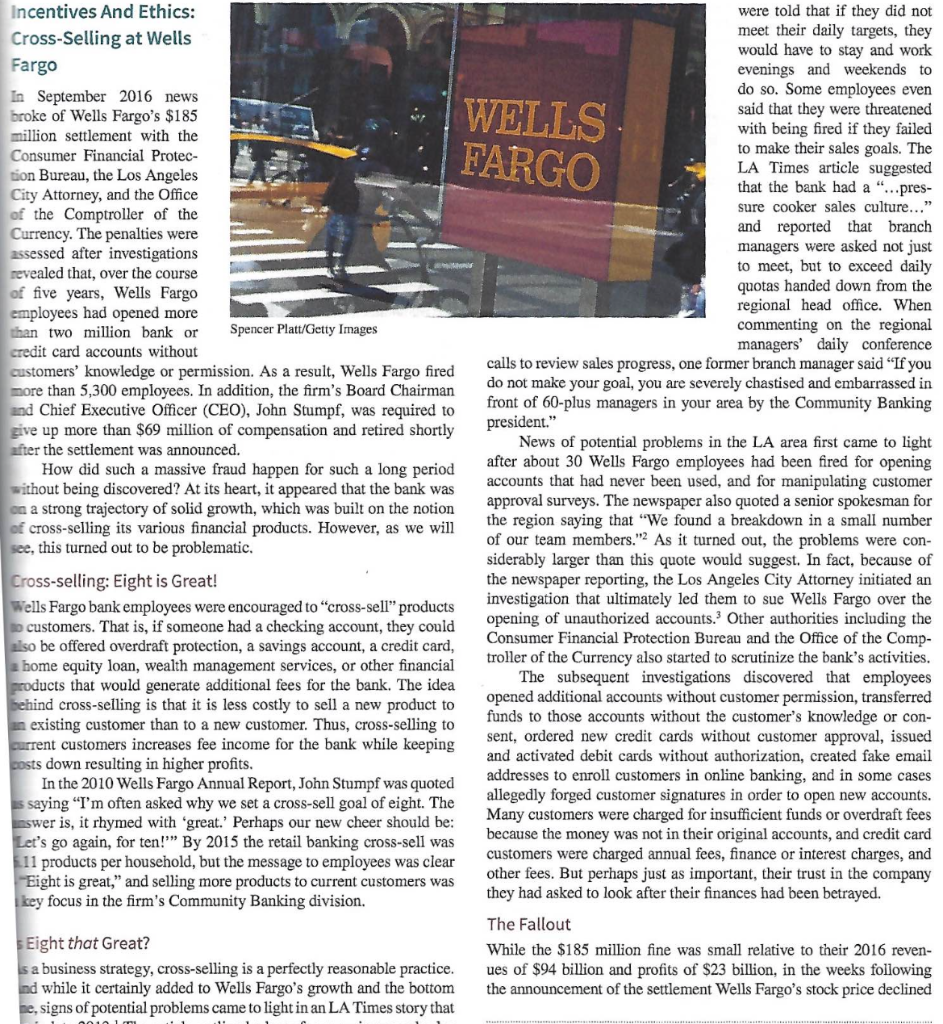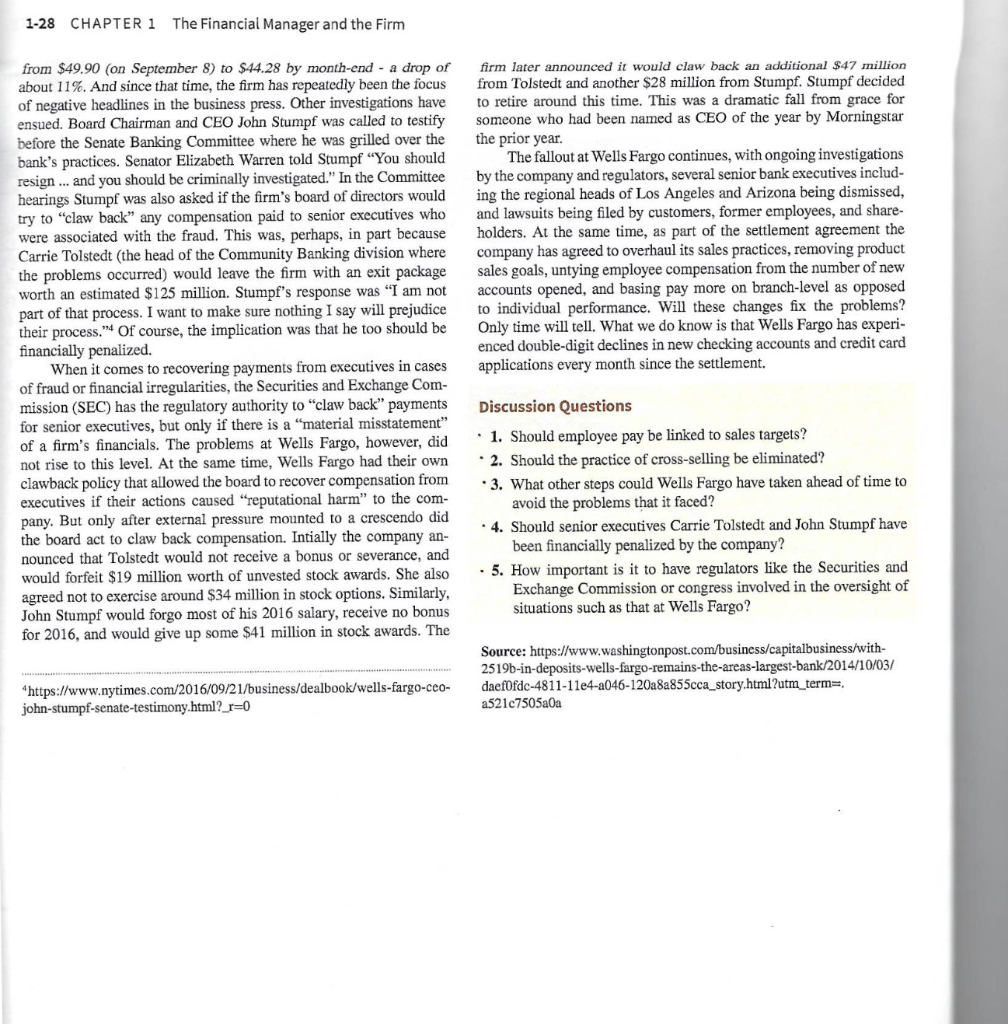Answered step by step
Verified Expert Solution
Question
1 Approved Answer
1. Should employee pay be linked to sales target? 2. Should the practice of cross-selling be eliminated? 3. What other steps could Wells Fargo have

 1. Should employee pay be linked to sales target?
1. Should employee pay be linked to sales target?
2. Should the practice of cross-selling be eliminated?
3. What other steps could Wells Fargo have taken ahead of time to avoid the problems that it faced?
4. Should senior executives Carrie Tolstedt and John Stumpf have been financially penalized by the company?
5. How important is it to have regulators like the Securities and Exchange Commission or congress involved in the oversight of the situations such as that at Wells Fargo?
WELLS FARGO Incentives And Ethics: Cross-Selling at Wells Fargo In September 2016 news broke of Wells Fargo's $185 million settlement with the Consumer Financial Protec- tion Bureau, the Los Angeles City Attorney, and the Office of the Comptroller of the Currency. The penalties were assessed after investigations revealed that, over the course of five years, Wells Fargo employees had opened more than two million bank or Spencer Platt/Getty Images credit card accounts without customers' knowledge or permission. As a result, Wells Fargo fired more than 5,300 employees. In addition, the firm's Board Chairman and Chief Executive Officer (CEO), John Stumpf, was required to give up more than $69 million of compensation and retired shortly after the settlement was announced. How did such a massive fraud happen for such a long period without being discovered? At its heart, it appeared that the bank was on a strong trajectory of solid growth, which was built on the notion of cross-selling its various financial products. However, as we will see, this turned out to be problematic. Cross-selling: Eight is Great! Wells Fargo bank employees were encouraged to cross-sell" products o customers. That is, if someone had a checking account, they could also be offered overdraft protection, a savings account, a credit card, home equity loan, wealth management services, or other financial products that would generate additional fees for the bank. The idea behind cross-selling is that it is less costly to sell a new product to in existing customer than to a new customer. Thus, cross-selling to current customers increases fee income for the bank while keeping posts down resulting in higher profits. In the 2010 Wells Fargo Annual Report, John Stumpf was quoted is saying "I'm often asked why we set a cross-sell goal of eight. The nswer is, it rhymed with great.' Perhaps our new cheer should be: Let's go again, for ten!"" By 2015 the retail banking cross-sell was 11 products per household, but the message to employees was clear Eight is great," and selling more products to current customers was key focus in the firm's Community Banking division. were told that if they did not meet their daily targets, they would have to stay and work evenings and weekends to do so. Some employees even said that they were threatened with being fired if they failed to make their sales goals. The LA Times article suggested that the bank had a "...pres- sure cooker sales culture..." and reported that branch managers were asked not just to meet, but to exceed daily quotas handed down from the regional head office. When commenting on the regional managers' daily conference calls to review sales progress, one former branch manager said "If you do not make your goal, you are severely chastised and embarrassed in front of 60-plus managers in your area by the Community Banking president." News of potential problems in the LA area first came to light after about 30 Wells Fargo employees had been fired for opening accounts that had never been used, and for manipulating customer approval surveys. The newspaper also quoted a senior spokesman for the region saying that "We found a breakdown in a small number of our team members." As it turned out, the problems were con- siderably larger than this quote would suggest. In fact, because of the newspaper reporting, the Los Angeles City Attorney initiated an investigation that ultimately led them to sue Wells Fargo over the opening of unauthorized accounts. Other authorities including the Consumer Financial Protection Bureau and the Office of the Comp- troller of the Currency also started to scrutinize the bank's activities. The subsequent investigations discovered that employees opened additional accounts without customer permission, transferred funds to those accounts without the customer's knowledge or con- sent, ordered new credit cards without customer approval, issued and activated debit cards without authorization, created fake email addresses to enroll customers in online banking, and in some cases allegedly forged customer signatures in order to open new accounts. Many customers were charged for insufficient funds or overdraft fees because the money was not in their original accounts, and credit card customers were charged annual fees, finance or interest charges, and other fees. But perhaps as important, their trust in the company they had asked to look after their finances had been betrayed. The Fallout While the $185 million fine was small relative to their 2016 reven- ues of $94 billion and profits of $23 billion, in the weeks following the announcement of the settlement Wells Fargo's stock price declined Eight that Great? is a business strategy, cross-selling is a perfectly reasonable practice. And while it certainly added to Wells Fargo's growth and the bottom me, signs of potential problems came to light in an LA Times story that 1-28 CHAPTER 1 The Financial Manager and the Firm from $49.90 (on September 8) to $44.28 by month-end - a drop of about 11%. And since that time, the firm has repeatedly been the focus of negative headlines in the business press. Other investigations have ensued. Board Chairman and CEO John Stumpf was called to testify before the Senate Banking Committee where he was grilled over the bank's practices. Senator Elizabeth Warren told Stumpf "You should resign ... and you should be criminally investigated." In the Committee hearings Stumpf was also asked if the firm's board of directors would try to "claw back any compensation paid to senior executives who were associated with the fraud. This was, perhaps, in part because Carrie Tolstedt (the head of the Community Banking division where the problems occurred) would leave the firm with an exit package worth an estimated $125 million. Stumpf's response was "I am not part of that process. I want to make sure nothing I say will prejudice their process." Of course, the implication was that he too should be financially penalized. When it comes to recovering payments from executives in cases of fraud or financial irregularities, the Securities and Exchange Com- mission (SEC) has the regulatory authority to "claw back" payments for senior executives, but only if there is a "material misstatement" of a firm's financials. The problems at Wells Fargo, however, did not rise to this level. At the same time, Wells Fargo had their own clawback policy that allowed the board to recover compensation from executives if their actions caused "reputational harm to the com- pany. But only after external pressure mounted to a crescendo did the board act to claw back compensation. Intially the company an- nounced that Tolstedt would not receive a bonus or severance, and would forfeit $19 million worth of unvested stock awards. She also agreed not to exercise around $34 million in stock options. Similarly, John Stumpf would forgo most of his 2016 salary, receive no bonus for 2016, and would give up some $41 million in stock awards. The firm later announced it would claw back an additional $47 million from Tolstedt and another $28 million from Stumpf. Stumpf decided to retire around this time. This was a dramatic fall from grace for someone who had been named as CEO of the year by Morningstar the prior year. The fallout at Wells Fargo continues, with ongoing investigations by the company and regulators, several senior bank executives includ- ing the regional heads of Los Angeles and Arizona being dismissed, and lawsuits being filed by customers, former employees, and share- holders. At the same time, as part of the settlement agreement the company has agreed to overhaul its sales practices, removing product sales goals, untying employee compensation from the number of new accounts opened, and basing pay more on branch-level as opposed to individual performance. Will these changes fix the problems? Only time will tell. What we do know is that Wells Fargo has experi- enced double-digit declines in new checking accounts and credit card applications every month since the settlement. Discussion Questions . 1. Should employee pay be linked to sales targets? 2. Should the practice of cross-selling be eliminated? 3. What other steps could Wells Fargo have taken ahead of time to avoid the problems that it faced? 4. Should senior executives Carrie Tolstedt and John Stumpf have been financially penalized by the company? . 5. How important is it to have regulators like the Securities and Exchange Commission or congress involved in the oversight of situations such as that at Wells Fargo? Source: https://www.washingtonpost.com/business/capitalbusiness/with- 2519b-in-deposits-wells-fargo-remains-the-areas-largest-bank/2014/10/03/ daef0fdc-4811-11e4-a046-120a8a855cca_story.html?utm_term=. a521c7505a0a "https://www.nytimes.com/2016/09/21/business/dealbook/wells-fargo-ceo- john-stumpf-senate-testimony.html?_r=0Step by Step Solution
There are 3 Steps involved in it
Step: 1

Get Instant Access to Expert-Tailored Solutions
See step-by-step solutions with expert insights and AI powered tools for academic success
Step: 2

Step: 3

Ace Your Homework with AI
Get the answers you need in no time with our AI-driven, step-by-step assistance
Get Started


